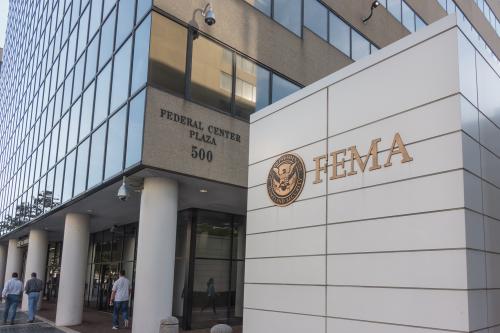The 2020 presidential election is finally behind us and my thoughts are turning to what the result means for climate action. The incoming Biden administration certainly favors action on climate. The administration’s transition team has already announced that former Secretary of State John Kerry will serve as a Special Presidential Envoy for Climate, and in that position, will sit on the National Security Council. But the makeup of the new Congress will likely make ambitious policies challenging to enact.
The United States will rejoin the Paris Agreement right away, but the question is, will other parties take our reengagement seriously? To be taken seriously abroad, the United States needs to get its ducks in a row at home, with policies to reduce emissions and increase climate resilience. The Obama administration faced a Republican Congress opposed to climate legislation, and thus used executive orders and regulations under existing laws to bring about emissions reductions. The drawback to this approach is that what one executive branch can do, the next can take away, as we’ve seen in the four years of the Trump administration. Since President-elect Biden will likely face a divided Congress as well, will it fall into the same trap, leaving U.S. climate policy swinging back and forth with the changing political wind? Our allies in the Paris Agreement have seen this movie before and didn’t much care for the ending.
With that in mind, I raised a question to my colleagues in the Brookings community: What should the Biden administration prioritize in its climate policy? As you would expect, they came up with a terrific group of proposals: practical, optimistic, and in line with today’s politics of increasing climate concern among the public.
Samantha Gross
Director, Energy Security and Climate Initiative
Fellow, Foreign Policy program and Energy Security and Climate Initiative
- A new focus on climate finance and risk management
- Climate change is a critical economic and risk management problem—the Biden administration should approach it accordingly
- Include national and subnational actors in ambitious planning
- Better land use practices and infrastructure
- Create a green learning agenda
- Pivot from methane laggard to leader
A NEW FOCUS ON CLIMATE FINANCE AND RISK MANAGEMENT
 David G. Victor, Nonresident Senior Fellow and Co-Chair of the Cross-Brookings Initiative on Energy and Climate, and Sadie Frank, Project Manager and Research Assistant in the Center for Security, Strategy, and Technology
David G. Victor, Nonresident Senior Fellow and Co-Chair of the Cross-Brookings Initiative on Energy and Climate, and Sadie Frank, Project Manager and Research Assistant in the Center for Security, Strategy, and Technology

While Democrats are celebrating Joe Biden’s victory, the legislative agenda faces stiff headwinds. When Biden takes office in January, he will be the first new president since George H.W. Bush in 1989 to move into the White House without his party controlling both houses of Congress. That’s trimmed expectations for a sweeping legislative agenda on topics such as a Green New Deal and shifted focus to a suite of administrative actions.
In the area of climate change, most regulatory discussions have focused on places like the Environmental Protection Agency (EPA), Department of Energy, and the Federal Energy Regulatory Commission. But the most profound regulatory changes could be those taking shape, quickly, in the unlikeliest of places: financial markets.
Over the last year alone there has been a sea change in how some American financial regulators have been thinking about climate change. The Federal Reserve under Jerome Powell has requested to join the Network for Greening the Financial System, an international group of central banks focused on addressing the financial risks of climate change. In the Securities and Exchange Commission there are noises that show, clearly, that regulators know we need to tighten up the rules for disclosure and oversight of markets. What’s most interesting in all this is that these recent efforts focus, as they should, on how the physical risks of climate change could affect financial stability.
All of this matters because once the financial markets see clear signals then capital will shift, and there will be no going back. Future administrations can roll back rules at the EPA, for example, as the Trump team did. But once the financial markets know the direction of travel they will travel. And that reallocation of capital will help cement a smarter approach to climate change in the country.
CLIMATE CHANGE IS A CRITICAL ECONOMIC AND RISK MANAGEMENT PROBLEM—THE BIDEN ADMINISTRATION SHOULD APPROACH IT ACCORDINGLY
 Sanjay Patnaik, Director of the Center on Regulation and Markets and the Bernard L. Schwartz Chair in Economic Policy Development in Economic Studies
Sanjay Patnaik, Director of the Center on Regulation and Markets and the Bernard L. Schwartz Chair in Economic Policy Development in Economic Studies
While the environmental impacts of climate change are frequently highlighted, it is becoming increasingly evident that climate change is a fundamental economic threat. With a growing number of extreme weather events and rising damages associated with a changing climate, even economically powerful countries like the U.S. will face unsustainable pressures on public budgets and the long-term viability of affected communities and firms. More importantly, climate change poses an unprecedented systemic risk to our economy and is a potent risk multiplier that exacerbates several other risks we face.
Focusing on climate change from an economic and risk management perspective is therefore imperative as it would allow the federal government to emphasize measures to address climate change that a broad range of stakeholders can get on board with. For instance, it is certainly not in the public interest to keep building new houses in increasingly flood-prone areas, to lose the ability to use certain military bases as they are impacted by climate change, or to build new infrastructure in places that face the rising threat of destruction through natural disasters. Identifying and developing ways to manage climate risks should therefore be a central aspect of a national climate policy, as it would reduce the economic harm climate change imposes on local and state governments, communities, and businesses. Importantly, it frames the problem in economic terms, which is a more powerful motivator for long-lasting changes in market behavior needed for the transition to a low-carbon economy. If the economic impact of climate change is incorporated at every level of decision-making throughout the federal government, it will send important signals to markets and steer resources toward low-carbon projects. This in turn will complement the already emerging market trends of large investors incentivizing companies to address their exposure to climate risks.
 Addisu Lashitew, David M. Rubenstein Fellow in the Global Economy and Development program
Addisu Lashitew, David M. Rubenstein Fellow in the Global Economy and Development program
The U.S. private sector faces the twin challenges of recovering from the devastating effects of the pandemic and transitioning to a low-carbon economy. Small and medium emprises (SMEs) that make up the vast majority of businesses were disproportionately hurt by the pandemic, which has significantly diminished their capacity to invest on new technologies for climate adaptation and mitigation. Small enterprises with less than 500 workers, which employ almost half of the U.S. labor force, in particular face severe liquidity constraints from the precipitous fall of demand and closure during the pandemic. A healthy economic recovery, therefore, will require smart policies that simultaneously support the competitiveness of SMEs and improve their capacity to invest in sustainable solutions.
The best way to achieve these objectives would be creating a Sustainable Finance Fund dedicated to SMEs. Building on the experiences of the Paycheck Protection Program and the Mainstreet Lending Program, the fund can be channeled on a commercial basis through financial institutions. It can be offered in the form of grants, loans, and guarantees to finance green projects such as research and development on green technologies and investments for improving energy efficiency and reducing pollution. The fund can also be used to bolster the capacity of the Small Business Administration agency to support the economic and climate resilience of SMEs.
Increased availability of sustainable financing will alleviate the liquidity constraints of many SMEs, helping them weather the economic crisis and avert avoidable bankruptcies. It will also incentivize SMEs to invest on green technologies, thus ensuring that climate transition gains momentum across the whole spectrum of businesses rather than remaining confined to larger enterprises. In addition to increasing competitiveness among SMEs, the fund will contribute to the growth and dynamism of the U.S. sustainable finance ecosystem.
ENGAGE NATIONAL AND SUBNATIONAL ACTIONS IN AMBITIOUS PLANNING
 Nathan Hultman, Nonresident Senior Fellow in the Global Economy and Development program
Nathan Hultman, Nonresident Senior Fellow in the Global Economy and Development program
The opportunity is now at hand for the incoming Biden-Harris administration to build a new, comprehensive, and ambitious national climate policy strategy for the United States, and to re-engage with the international community to address climate globally. Such a strategy would catalyze a broad American economic transformation that delivers a vibrant economy and broadly shared benefits while also delivering significant emissions reductions that support scientifically informed global climate goals. While the outgoing president has, in his typical style, fed an apocalyptic narrative around climate inaction in the United States, the reality is far different. Even as the executive branch wrought damage to federal policies and international engagements, actions across the country from subnational leaders (in states, cities, businesses, and others), combined with quickly evolving clean technology market trends and shifts in public opinion, have built a stepped-up basis for accelerating action nationally from the bottom up. The U.S. is therefore in a strong position for a rapid and vigorous re-engagement by the federal government.
A central component that links the domestic climate policy strategy to support higher international action from other countries is the climate target that the U.S. will communicate as part of the Paris Agreement, called the Nationally Determined Contribution, or NDC. This will be generated by developing a new, “all-in” climate policy strategy that fuses new federal actions from the executive and potentially Congress (for example, as part of a stimulus and recovery package), with existing and new actions from an expanding set of subnational actors such as states, cities, businesses, and investors. This NDC process also creates a critical opportunity to integrate key stakeholders—to gather input, solicit feedback, generate broader understanding of the opportunities and constraints for action, and even to invite greater action from subnational actors. Such an integrated process can not only build a more broadly rooted strategy with more widely understood domestic benefits and long-term robustness, but also can increase international confidence and thereby create leverage for other countries to do more as well.
A full set of recommendations for developing such a national strategy and a new U.S. NDC for the Paris Agreement, including the role of sub-national actors, is described in this new Brookings–University of Maryland white paper. Opportunities for the U.S. to drive an “all-of-society” international strategy to raise global ambition are presented here. Strategies for fusing subnational action into national NDC strategies in the U.S. and global contexts are presented here.
 Amar Bhattacharya, Senior Fellow in the Global Economy and Development program
Amar Bhattacharya, Senior Fellow in the Global Economy and Development program
The incoming Biden administration has set three interrelated priorities: building back better; energy and climate; and investing in sustainable infrastructure. In addition to the domestic pursuit of this combined agenda, an early and strong focus on international cooperation can inject the necessary drive and political will to reset the global economy for stronger and more inclusive growth and regain lost momentum on international climate action.
The immediate priority for global cooperation is ensuring a better recovery from the pandemic. The world has been transformed by the COVID-19 pandemic, which has highlighted the dangers and fragilities that had been building in the world economy and the planet. The crisis presents an enormous threat but also a one-off, last chance opportunity—to restructure economies at the pace and scale that the climate crisis requires.
The agenda for international cooperation must encompass coordinated fiscal support to achieve the scale and quality of investment needed to drive recovery and transformation, stronger policy measures to accelerate the transition to a low-carbon economy especially the adoption of carbon pricing and elimination of fossil fuel subsidies, and concerted actions to overcome the debt and financing constraints that are holding back ambition especially in the developing world.
Europe has shown the way on this agenda through its green deal and recovery program. Broader global action has been held back so far by U.S. reticence to make this agenda a global priority and engage multilaterally. An early engagement of the U.S. in the upcoming UK G7 and Italian G20 Presidencies in 2021 and in the United Nations bodies in the lead up to next year’s summits can be a game changer. The U.S. should also tap the momentum that has been building in the private sector and in local governments. And it should join two important coalitions that have emerged over the past two years: The Coalition of Finance Ministers for Climate Action and the Network for Greening the Financial System.
BETTER LAND USE PRACTICES AND INFRASTRUCTURE
 Jenny Schuetz, Fellow in the Metropolitan Policy Program and Future of the Middle Class Initiative
Jenny Schuetz, Fellow in the Metropolitan Policy Program and Future of the Middle Class Initiative
Better land use practices are critical to slowing down climate change. Where the U.S. builds homes and workplaces—and what kind of transportation systems connect these two—has profound implications for greenhouse gas emissions.
For the past 50 years, the U.S. has allowed too many homes to be built in locations that are environmentally vulnerable and/or damaging. Within large metro areas, most new housing is constructed at the urban fringe, far from job centers and public transportation, and in car-dependent locations. Entire communities have been built in parts of the country that frequently and predictably suffer from weather events and natural disasters: coastal areas and adjacent to rivers prone to flooding and hurricane damage, Western lands subject to wildfires. The harms wrought by climate change are not shared evenly: Black and brown communities often bear the brunt of natural disasters. Each year, we see more evidence of the devastating financial and human costs of building homes in the “wrong” places—and yet we continue to do it.
Two types of federal action are needed to reform harmful land use. First, the federal government should develop clear, consistent guidelines on the geographic patterns of climate risks and impacts. These guidelines should be used to assess all federal investments, including transportation, housing, and infrastructure subsidies, as well as disaster recovery. Second, the federal government should coordinate with state and local governments in revising land use regulations to limit further development in sensitive and harmful areas.
 Adie Tomer, Fellow in the Metropolitan Policy Program
Adie Tomer, Fellow in the Metropolitan Policy Program
The next administration needs to start reducing transportation-related emissions, and fast. Transportation is now the country’s top polluting sector and the greatest impact comes from personal travel. It’s also not hard to understand how we got here. The combination of large lot homes, vast parking lots around our jobs and shopping centers, and highways to connect it all created a land use environment where driving is often the only choice for most people. Even worse, those driving distances keep getting longer as our metropolitan borders keep getting bigger. Yet our recent work shows there is a better way. Neighborhoods designed at a human-scale—ones with greater proximity between homes and destinations—lead to far shorter trips. The problem is most of metropolitan America stopped building these neighborhoods long ago. And it will take decades to either retrofit newer suburbs or build more housing in human-scale neighborhoods. This leaves local and national leadership with a dilemma.
To avoid the worst impacts of rising global temperatures, we need to reduce fossil fuel use. But pushing people to electric vehicles (EVs) only maintains the status quo, incentivizing more sprawl and long-distance trips. On top of that, federal leaders have limited authority over land use. How can the country avoid unsustainable land use if thousands of communities have individual control? The answer is phasing with purpose. If people are stuck driving, then we have to get people into EVs through incentives and the forced retirement of gas-powered cars. Then let’s use the EV transition to buy time to build human-scale neighborhoods—adopting policies like impact fees and vehicle miles traveled taxes to disincentivize sprawl and coupling them with land value taxes and multimodal transportation to boost development near the core. The federal government may not control land use, but it can tie its investments in transportation assets, housing, and environmental programs to this grand goal. We have little time to wait.
 Joseph W. Kane, Senior Research Associate and Associate Fellow in the Metropolitan Policy Program
Joseph W. Kane, Senior Research Associate and Associate Fellow in the Metropolitan Policy Program
The incoming Biden administration has a long list of potential climate priorities—from clean energy production to electric vehicles to building retrofits. While reducing greenhouse gas emissions and mitigating the worst effects of climate change are essential, the U.S. also must adapt to the current reality of extreme storms, chronic flooding, and other climate impacts. Although often overlooked, improving our water infrastructure can do just that.
Water policy is climate policy. Our drinking water, wastewater, and stormwater needs all relate to mounting concerns around environmental quality, resource efficiency, and climate resilience—polluted rivers, leaking pipes, inundated levees, the list goes on. Many state and local leaders, including water utilities, have long acted on these concerns. But the magnitude of our water challenges demand more proactive federal leadership and investment, which can also accelerate several economic priorities: addressing regional divides in places like Flint, Michigan, improving household affordability, boosting technological innovation, and supporting long-term career pathways.
Executive action can improve our water and climate outcomes. Strengthened federal protections around sensitive streams and wetlands would offer a start. Additional federal guidance on emerging financial tools and collaborations—such as environmental impact bonds—could also incentivize more public and private green infrastructure investment. And ensuring a broader range of federal agencies are involved in these efforts—from the EPA to the USDA to Treasury—would establish greater policy consistency and direction.
But even in a divided Congress, water has a long history of bipartisan appeal, and there is potential for new infrastructure legislation to address climate, too. Upgrading pipes, plants, and other water facilities is unlikely to generate much political buzz, but it would offer a steady and dependable way to tackle some of our biggest climate needs.
CREATE A GREEN LEARNING AGENDA
 Christina Kwauk, Fellow in the Global Economy and Development program and Center for Universal Education
Christina Kwauk, Fellow in the Global Economy and Development program and Center for Universal Education
The Biden-Harris Climate Plan rightfully points to the need to support coal miners, power plant workers, and other communities that will be affected by a transition to a clean energy economy. However, such limited attention to the reskilling of a small subset of the American population is not enough to realize the ambitious goal for the U.S. to achieve net-zero emissions by 2050.
Our ability as a nation to accelerate climate action demands a cultural shift and a mindset change at scale around how Americans view and are taught implicitly and explicitly to view the separation of human systems from natural systems, the social from the ecological. Such attitudes are deeply interconnected with those that help to normalize environmental racism, gender inequalities, and social inequities–the domination and exploitation of one by another.
To rebalance U.S. emissions, we must redress power inequalities among historically and newly disadvantaged Americans, including women, Black, indigenous, and people of color, and displaced coal workers.
To do so requires a new green learning agenda (detailed in a forthcoming Brookings report) that at its core upholds principles of fairness, equity, and justice. It must equip learners of all ages to prioritize care and the well-being of others, including the natural world. And it must teach, implicitly and explicitly, that unequal relations of power are just as destructive to life on this planet as an imbalance of greenhouse gases. At a minimum this must include education about climate change and the development of sustainability competencies and green skills.
If President-elect Biden wants to put America on a course to net-zero by 2050, his plan must remove the roadblocks that prevent all learners—young and old—from receiving quality education and training for climate action.
PIVOT FROM METHANE LAGGARD TO LEADER
 Barry Rabe, Nonresident Senior Fellow in Governance Studies
Barry Rabe, Nonresident Senior Fellow in Governance Studies
The abiding climate policy focus on carbon overshadows methane, which has triggered one-quarter of global warming to date. Methane is the primary constituent of natural gas, often characterized as “low-hanging fruit.” This reflects numerous common-sense ways to minimize flaring and venting while capturing rather than squandering value from a non-renewable natural resource.
That fruit, however, often goes unpicked. Generations of state-based regulatory oversight of oil and gas production has remained highly accommodating. Many states struggle to produce credible measures of methane releases and backpedal whenever industry finds regulations inconvenient.
It may be tempting for Team Biden to simply “reverse the reversal,” following Trump efforts to eviscerate federal standards developed during the Obama years. Instead, they should go father, building upon a handful of best-practice cases.
Colorado and New Mexico have begun pulling away from the state pack. Colorado builds on an early foundation of innovation with new legislation and regulations designed to halt most flaring and venting. New Mexico takes creative steps cognizant of extreme industry performance variation, intensifying oversight of firms with poor methane records while easing pressures when measurable performance proves robust.
Canada honors its 2016 agreement with the U.S. and Mexico to achieve deep methane emission cuts by 2025. Alberta creates a system to more reliably measure releases, improve public disclosure practices, tighten performance standards, and cost-share mitigation technology purchase through a levy on firms missing emission-reduction targets. Mexico passed far-reaching methane legislation two years ago, though American dawdling gives it license to waiver.
The Biden administration could declare that America is finally ready to lead on methane mitigation. It could design a suite of world-class regulatory and disclosure tools to minimize methane releases for as long as oil and gas continue to be used. A stretch goal would establish an upstream fee on releases, funding remediation of tens of thousands of abandoned drilling sites that seep methane and pose additional environmental and safety risks.















Commentary
Around the halls: What should the Biden administration prioritize in its climate policy?
November 23, 2020